|
|
Research Progress on Nanostructured Metal Oxides as Anode Materials for Li-ion Battery
ZHENG Shiyou, DONG Fei, PANG Yuepeng, HAN Pan, YANG Junhe
2020 Vol. 35 (12): 1295–1306
 Abstract
Abstract(
1365 )
 HTML
HTML(
108)
 PDF
PDF(5741KB)(
1461
)
Anode material is an important component for Li-ion battery. The current anode materials are mainly based on graphite, which possesses low theoretical specific capacity of 372 mAh/g, and thus hinder the further development of Li-ion battery. Among the newly developed anode materials, metal oxides have recently attracted intense attention due to their high theoretical specific capacity, low cost and environmental friendliness. However, metal oxides own poor electrical conductivity and large volume changes during cycling. Nanosizing can overcome these disadvantages while maintaining the advantages for metal oxide based anode materials, and thus becomes a research hot spot. Herein, we review the recent research advances of the nanostructured metal oxides as anode materials, mainly focusing on the microstructure design and performance optimization of representative metal oxides and their composites. In addition, some suggestions are presented for further explorations in relative fields.
|
|
|
Progress in the Preparation and Application of Nanostructured Manganese Dioxide
WANG Jinmin, YU Hongyu, MA Dongyun
2020 Vol. 35 (12): 1307–1314
 Abstract
Abstract(
2063 )
 HTML
HTML(
97)
 PDF
PDF(3906KB)(
2217
)
As an important transition metal oxide, manganese dioxide (MnO2) has attracted more and more attention due to its abundant reserves, varied crystal types and excellent material properties. Nanostructured MnO2 has smaller size and larger specific surface area, that makes it can further optimize its material properties and expand its application fields. In the introduction, this article starts with the introduction of the application of manganese dioxide, and points out that nanostructuring and variability in crystal form have an important influence on the structure and properties of manganese dioxide. The main text summarizes and reviews the research progress in recent years from two aspects: the preparation methods and the applications of nanostructured MnO2. (1) This paper introduces the progress in the preparation methods of nanostructured MnO2 including hydrothermal, Sol-Gel, chemical precipitation, solid-phase synthesis. Then the advantages and disadvantages of preparation methods, the morphologies and properties of nanostructured MnO2 are summarized. (2) The applications of nanostructured MnO2 including energy-storage electrodes, electrochromic devices, catalysts and bio-sensors are reviewed. Nanostructured MnO2 can be used as the cathode material of batteries and the electrode material of supercapacitors. Manganese- containing composite oxides prepared by adjusting the crystal form of MnO2 and compounding are used as the cathode material of the lithium ion batteries, which can increase the capacities and improve the cycle stability of batteries. It has been industrialized as a cathode material for lithium-ion power batteries, and has good application prospects in the field of new energy vehicles. As the electrode material of electrochromic devices, MnO2 is usually used by combining with other materials with large optical modulations since the color of pure MnO2 mainly changes between brown and yellow and its optical modulation is small. For example, polyaniline/MnO2 hybrid electrochromic film has a great difference in morphology, structure and electrochromic performance compared with pure polyaniline film, showing higher optical modulation, coloration efficiency and cycle stability. Nanostructured MnO2 plays important roles in the catalytic conversion of ethylbenzene and the catalytic elimination of air pollutants. Nanostructured MnO2 can increase the current response, reduce the detection limit, and greatly improve the sensitivity of detection. In recent years, it has been gradually paid attention to and widely used in the field of biosensors. For example, MnO2 nanosheets assisted fluorescence polarization biosensors can be effective in detection of Ag+ in environmental water samples, PtAu-MnO2 binary nanostructures modified graphene paper show good sensing performance in non-enzymatic glucose detection. In conclusion part, current existing problems are analyzed. The development direction of nanostructured MnO2 applied in lithium-ion battery cathode materials and electrochromic devices are pointed out. The future prospects for development of nanostructured MnO2 are discussed.

|
|
|
Blowing Route to Fabricate Foams of 2D Materials
GAO Tian, XIAO Qinglin, XU Chenyang, WANG Xuebin
2020 Vol. 35 (12): 1315–1326
 Abstract
Abstract(
1239 )
 HTML
HTML(
45)
 PDF
PDF(5111KB)(
1240
)
Graphene, as a representative of two-dimensional (2D) materials, has excellent intrinsic properties such as high specific surface area and conductivity, but its macroscopic bulk behaves poorly owing to severe face-to-face restacking and hand-in-hand contact resistance. Three-dimensional (3D) design of 2D materials can deliver the excellent nanoscaled properties to the macroscopic world, to realize the high surface area, conductivity, interconnected pores, and good mechanics of the bulks. It is necessary and highlighted to develop the porous monolith of 2D materials for applications as electrodes, adsorbents, elastomers, etc. The blowing route has the advantages of low cost and simple processing, which has been accentually developed to produce the foams of 2D materials for several years. This article introduces the principle of the blowing method, summarizing the recent examples of blown foams of graphene, boron nitride nanosheet, and others. The scientific front about foams of 2D materials is discussed, and the broad applications of the new materials are prospected in energy, environment, etc.
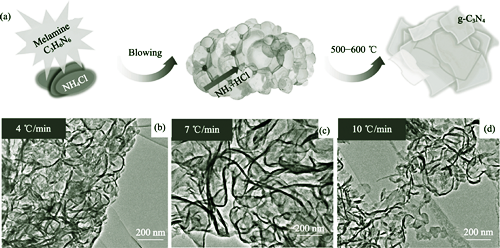
|
|
|
Damage Characteristics of 2D C/SiC-ZrC Composites under Low Velocity Impact
PI Huilong, ZHANG Baopeng, YU Xinmin, LIU Wei, JIN Xin
2020 Vol. 35 (12): 1327–1332
 Abstract
Abstract(
556 )
 HTML
HTML(
18)
 PDF
PDF(5776KB)(
730
)
The effects of impact energy on damage characteristics and tensile properties of 2D C/SiC-ZrC composites were studied by low-speed impact, post-impact tensile tests and the CT scanning methods. The results indicated that C/SiC-ZrC composites had a high impact damage tolerance. The damage state of the composites in the energy range of 15-24 J was mainly shown as penetrating damage. When the impact energy increased within the range of 15-24 J, the nominal tensile strength of C/SiC-ZrC composites reduced slowly, with a maximum decrease of around 25%. The impact mainly caused lamination and fiber fracture damage near the impact areas. However, the impact damage was not observed out of the impact areas.
|
|
|
Fabrication of Dual-layer Hollow Fiber Ceramic Composite Membranes by Co-extrusion
LIU Jinyun, ZHANG Yuting, HONG Zhou, LIU Hua, WANG Shengxian, GU Xuehong
2020 Vol. 35 (12): 1333–1339
 Abstract
Abstract(
492 )
 HTML
HTML(
32)
 PDF
PDF(1989KB)(
744
)
Hollow fiber ceramic membranes have been widely accepted in membrane separation due to their advantages of high packing density, low transfer resistance and long-period operation. Fabrication of highly-asymmetric hollow fiber membrane is helpful to achieve high flux as well as high rejection simultaneously. In this work, dual-layer hollow fiber ceramic composite membranes were prepared by the co-extrusion method. The inner and outer suspensions were doped with α-Al2O3 powders with average particle sizes of 1 μm and 300 nm respectively. Effects of TiO2 content in inner suspension, Al2O3/polyether sulfone (PESf) mass ratio of outer suspension and calcination temperature on structure and properties of membrane were investigated extensively. When the TiO2 content was 2wt% in inner suspension, the Al2O3/PESf mass ratio was 5.60 in outer suspension and the sintering temperature was 1350 ℃, the hollow fiber membrane got the optimum performance, with fracture load of 24 N, average pore size of 0.15 μm, and oil rejection of 97.5%.
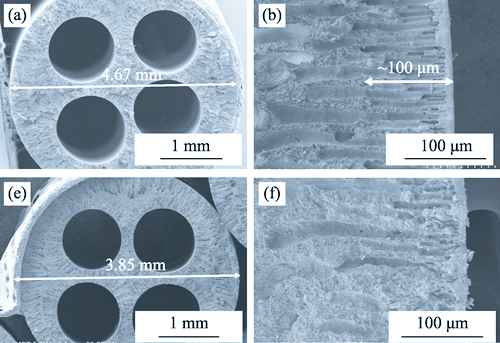
|
|
|
Photocatalytic Reduction of Re (VII) on Amorphous TiO2/g-C3N4 Derived from Different N Sources
WANG Xucong, DENG Hao, JIANG Zhongyi, YUAN Liyong
2020 Vol. 35 (12): 1340–1348
 Abstract
Abstract(
571 )
 HTML
HTML(
28)
 PDF
PDF(1142KB)(
745
)
To clarify the effect of N sources on the photocatalytic reduction of Re (VII) in amorphous TiO2/g-C3N4 (TCN) composites, g-C3N4 were prepared via a thermal decomposition of three precursors (Urea, Thiourea and Melamine). Three kinds of TCN composite photocatalysts were then prepared by recombining with amorphous TiO2 separately. All three photocatalysts were characterized by differnent methods, and their differences in photocatalytic reduction of Re(VII) were compared in detail. The experimental results show that U-TCN using urea as the N source has more uniform appearance, the largest specific surface area (474 m2/g), and the most excellent light absorption performance, leading to its photocatalytic reduction efficiency (90%) for Re (VII) being significantly higher than T-TCN (20%) and M-TCN (15%). Transient photocurrent and electrochemical impedance (EIS) analyses prove that U-TCN exhibits the highest efficiency of photo-generated electron/holes separation. Electron paramagnetic resonance spectroscopy (EPR) analysis shows that U-TCN generates more hydroxyl radicals (?OH), so that there are stronger reducing ?CO2 radicals produced by the reaction with formic acid, which is more conducive to the reduction of Re (VII). X-ray absorption spectra are employed to analyze the valence state and coordination environment of Ti element, which demonstrates an excellent photochemical stability of U-TCN. The study not only illustrates the effects of N sources on the photocatalytic performance of TCN composites, but also provides a promising photocatalyst for reduction and removal of Tc(VII) from waste water.
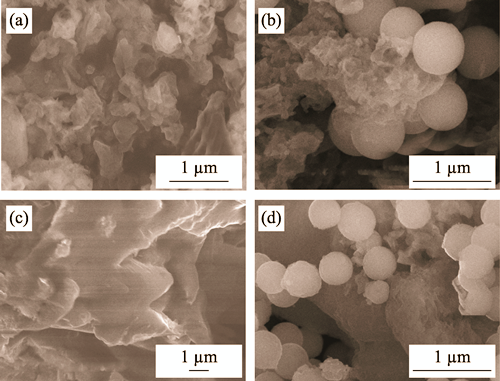
|
|
|
Lattice Control of WO3 Nanoflowers by Heat Treatment and Construction of WO3/CdS/α-S Heterojuntion
LIN hai, SU Weitao, ZHU Yu, PENG Pai, FENG Miao, YU Yan
2020 Vol. 35 (12): 1349–1356
 Abstract
Abstract(
639 )
 HTML
HTML(
17)
 PDF
PDF(4566KB)(
891
)
In order to study the influence mechanism of heat treatment and heterostructures on the photoelectrochemical effect of WO3, monoclinic WO3 nanoflowers were synthesized by low-temperature solvothermal method. The active crystal fact, grain size and crystallinity of WO3 were controlled by heat treatment. Furthermore, WO3/CdS/α-S heterojunction was obtained by modified chemical bath deposition, and the concentration effect of its photoelectrochemical performance was studied. The results show that the (200) crystal plane with photoelectrochemical activity is the main exposed crystal plane of WO3, and the proportion of the exposed crystal plane increases with the heat treatment temperature increasing. The WO3 nanoflower treated at 350 ℃ showed the highest photoresponse current. By constructing WO3/CdS/α-S heterojunction, the material's absorption in the visible light region is enhanced, and the overall efficiency of photo-generated carrier separation is improved by sacrificing a small amount of carriers, which promotes the macroelectronic chemical effects of WO3.
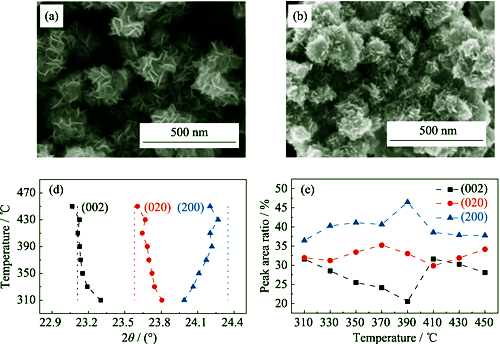
|
|
|
In-situ Polymerization Integrating 3D Ceramic Framework in All Solid-state Lithium Battery
YAN Yiyuan, JU Jiangwei, YU Meiyan, CHEN Shougang, CUI Guanglei
2020 Vol. 35 (12): 1357–1364
 Abstract
Abstract(
816 )
 HTML
HTML(
40)
 PDF
PDF(6598KB)(
1110
)
Organic/inorganic composites have been considered as promising electrolyte candidates in all solid-state lithium batteries. Aiming at improving the conductivity significantly by increasing the frequently-used 0D or 1D ceramic nano-fillers to high content is unsuccessful due to the particle tendency to agglomeration. What's worse, the loose contact between the solid electrolyte and solid electrodes is much of a serious barrier to the performance and thus to the application of all solid-state lithium batteries. Herein, self-supported 3D porous Li6.4Al0.1La3Zr1.7Ta0.3O12 frameworks are employed to provide percolated fast Li+ conductive pathway while in-situ polymerization of poly(ethylene glycol) methyl ether acrylate can integrate the loose solid-solid interface and reduce the interfacial resistance efficiently. Inspiringly, the Li+ conductivity of the composite exhibits 1.9×10-4 S·cm-1 at room temperature. The interfacial resistance in Li-Li batteries decreases significantly from 1540 to 449 Ω·cm 2, rendering good capacity and cyclability of the 4.3 V (vs. Li+/Li) LiCoO2|Li all solid-state lithium battery.
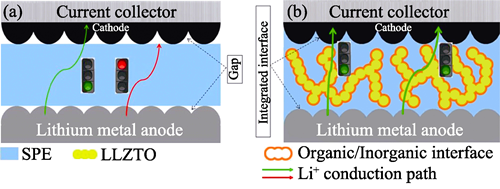
|
|
|
Preparation of Mesoporous Organosilica-based Nanosystem for in vitro Synergistic Chemo- and Photothermal Therapy
ZENG Yulin, CHEN Jiajie, TIAN Zhengfang, ZHU Min, ZHU Yufang
2020 Vol. 35 (12): 1365–1372
 Abstract
Abstract(
587 )
 HTML
HTML(
14)
 PDF
PDF(2166KB)(
663
)
Organic-inorganic hybrid mesoporous organosilica has gained more attention in biomedicine due to its high surface area, mesoporous channels, functional framework, and high drug loading capacity. In this study, disulfide- bridged hybrid mesoporous organosilica nanoparticles (MONs) as nanocarriers were employed to construct a nanosystem (ICG/DOX-MONs@DNA20) for delivering drugs and photothermal agents, in which DNA molecules as “switches” were modified on the surface of MONs to control drug release. The results showed that the ICG/DOX-MONs@DNA20 nanosystem could increase the temperature to above 43 ℃ for photothermal therapy with near-infrared (NIR) laser irradiation. On the other hand, the ICG/DOX-MONs@DNA20 nanosystem exhibited a very slow release of DOX (12.3% in 6 h) at 37 ℃, but a rapid release of DOX (52.4% in 6 h) occurred at 43 ℃. Cell culture experiments indicated that the nanosystem can be internalized by HeLa cells, and exhibited an enhanced therapeutic efficacy of synergistic chemo- and photothermal therapy. Hence, the ICG/DOX-MONs@DNA20 nanosystem might be promising for synergistic chemo- and photo-thermal tumor therapy.
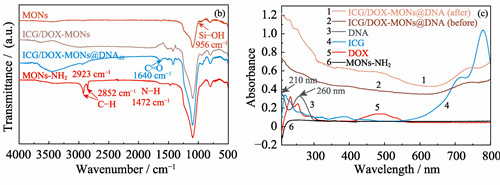
|
|
|
Optimization of Thermoelectric Transport Properties of Nb-doped Mo1-xWxSeTe Solid Solutions
ZHOU Xingyuan, LIU Wei, ZHANG Cheng, HUA Fuqiang, ZHANG Min, SU Xianli, TANG Xinfeng
2020 Vol. 35 (12): 1373–1379
 Abstract
Abstract(
636 )
 HTML
HTML(
30)
 PDF
PDF(650KB)(
731
)
Solid solutions forming and doping is an effective approach to optimize the transport properties of thermoelectric materials. In this study, a series of single-phase Mo1-xWxSeTe (0≤x≤0.5) solid solutions and their Nb-doped products were successfully synthesized with solid-state reaction followed by rapid sintering utilizing a Plasma Assisted Sintering apparatus. Thermoelectric transport studies showed that the carrier concentration, carrier mobility, electrical conductivity and power factor of the Nb2yMo0.5-yW0.5-ySeTe solid solutions were significantly increased by W substitution and Nb doping, while their lattice thermal conductivity was reduced, leading to remarkably enhanced dimensionless figure of merit ZT. The simultaneous increment of carrier density and carrier mobility with the increasing Nb content is due to the transition from discrete energy levels to continuous impurity band through Nb doping. The study of anisotropy indicated that, Nb2yMo0.5-yW0.5-ySeTe solid solutions owned a higher ZT value along the //P direction as a result of the lower lattice thermal conductivity. The Nb0.03Mo0.485W0.485SeTe compound presented the highest ZT values among all samples, which were 0.31 and 0.36 (@823 K) along the ⊥p and //P directions, respectively, representing one of the best results based on MoSe2-based materials. The enhancement of the Seebeck coefficient and the power factor is expected to further improve the ZT values of MoSe2-based compounds by optimizing the doping elements.
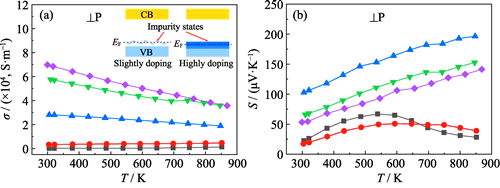
|
|
|
Dielectric, Ferroelectric and Piezoelectric Properties of Pb(In1/2Nb1/2)O3-Pb(Ni1/3Nb2/3)O3-PbTiO3 Ternary Ceramics Near Morphotropic Phase Boundary
GUO Lin, QIAO Xianji, LI Xiuzhi, LONG Xifa, HE Chao
2020 Vol. 35 (12): 1380–1384
 Abstract
Abstract(
669 )
 HTML
HTML(
20)
 PDF
PDF(869KB)(
921
)
Lead-based complex perovskite ferroelectric materials have been widely used as electromechanical sensors, actuators, and transducers. Among them, Pb(Ni1/3Nb2/3)O3-PbTiO3 (PNN-PT) based solid solution has been drawn much attentions of scientists for its excellent dielectric and piezoelectric properties near morphotropic phase boundary (MPB) region. However, the relatively high dielectric loss and low Curie temperature near MPB region limited its application in high temperature and high power devices. In this work, Pb(In1/2Nb1/2)O3 (PIN) was introduced into PNN-PT ceramics for improving their electrical properties and Curie temperature. The ternary ferroelectric ceramics Pb(In1/2Nb1/2)O3-Pb(Ni1/3Nb2/3)O3-PbTiO3 were successfully prepared by a two-step synthesis process. All samples exhibited pure perovskite phase without any secondary phase. The structure transferred from rhombohedral to tetragonal phase with increasing PT content. The MPB phase diagram of ternary system at room temperature was established based on XRD results. The values of Curie temperature were improved significantly after PIN added into PNN-PT system. Importantly, the introduction of PIN into PNN-PT system can effectively reduce dielectric loss and conductivity. The ceramics in the MPB region exhibited excellent properties. 0.30PIN-0.33PNN-0.37PT ceramic was found to have optimal properties with d33=417 pC/N, TC=200 ℃, ε′= 3206, tanδ=0.033, Pr=33.5 μC/cm2 and Ec=14.1 kV/cm at room temperature, respectively. The Curie temperature and piezoelectric coefficient were improved while dielectric loss and conductivity were reduced after the introduction of PIN into PNN-PT. The enhancements of piezoelectric properties and high Curie temperature make this ternary system a promising material for high power and high temperature transducer applications.
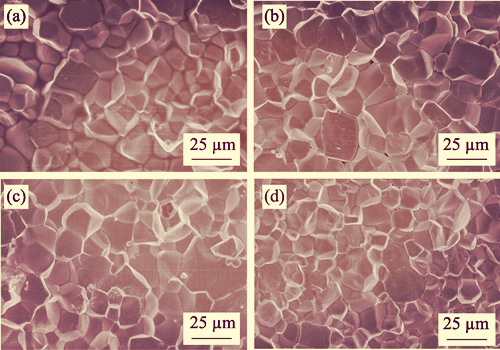
|
|
|
Stable Zirconium Carbide Fibers Fabricated by Centrifugal Spinning Technique
CHEN Bowen, WANG Jingxiao, JIANG Youlin, ZHOU Haijun, LIAO Chunjing, ZHANG Xiangyu, KAN Yanmei, NI Dewei, DONG Shaoming
2020 Vol. 35 (12): 1385–1390
 Abstract
Abstract(
593 )
 HTML
HTML(
22)
 PDF
PDF(3762KB)(
787
)
In this work, an efficient approach was presented to produce stable zirconium carbide (ZrC) fibers by centrifugal spinning technique. Zirconium acetate and sucrose were used as the zirconium source and carbon source respectively. And polyvinyl pyrrolidone (PVP) was used as the spinning aid. After pyrolysis and carbothermal reduction at 1600 ℃, the as-spun green fibers can be converted to homogeneous ZrC fibers composed of uniform nano-sized ZrC crystals. Moreover, it is revealed that the as-fabricated ZrC fibers can sustain superior microstructure stability at an ultra-high temperature up to 2000 ℃, benefiting from a limited amount of residual carbon. The reaction mechanisms and the resulted ZrC fibers were also investigated.
|
|
|
A Layered Uranyl Coordination Polymer with UV Detection Sensitivity, Stability, and Reusability
CHEN Lei, CHEN Lanhua, ZHANG Yugang, XIE Jian, DIWU Juan
2020 Vol. 35 (12): 1391–1397
 Abstract
Abstract(
622 )
 HTML
HTML(
10)
 PDF
PDF(1908KB)(
779
)
The sensitive detection of UV light is critical in industrial production and for personal protection, and the aim of this research is to develop novel UV detection materials. The uranyl unit generally exhibits relatively high UV absorption efficiency and strong fluorescence intensity. Hence in this work, a uranyl coordination polymer compound [(TEA)2(UO2)5(PhPC)6] (TEA = tetraethylammonium ion, PhPC = (2-carboxyethyl)phenylphosphinic acid, denoted as UPhPC-1) was successfully synthesized via the hydrothermal method. The structural analysis of UPhPC-1 based on the single crystal XRD data elucidates that there are three crystallographically unique uranyl centers. Two uranyl units are in the pentagonal bipyramidal geometry, while the third one is in the tetragonal bipyramidal geometry. All three uranyl units are connected by the ligands to form infinite uranyl layers in the [bc] plane, which are packed via hydrogen bonding networks and π-π interactions to yield the overall layered structure. The stability test results of UPhPC-1 demonstrate that the compound exhibits good thermal and hydrolytic stability with high radiation resistance. Moreover, results of the UV irradiation experiments show that the intrinsic luminescence of UPhPC-1 is highly sensitive to 365 nm UV irradiation with a low detection limit and a fast response rate. A negative correlation between the emission intensity and the UV irradiation dosage was then established. The electron paramagnetic resonance data analysis strongly supports the production of radicals in UPhPC-1 under UV radiation, which leads to the partial quenching of the uranyl fluorescence. Furthermore, the radicals in the quenched sample can be readily eliminated by heating, resulting in the recovery of the photoluminescence intensity of UPhPC-1. The current results suggest suitable application potential of UPhPC-1 in the field of quantitative UV detection.
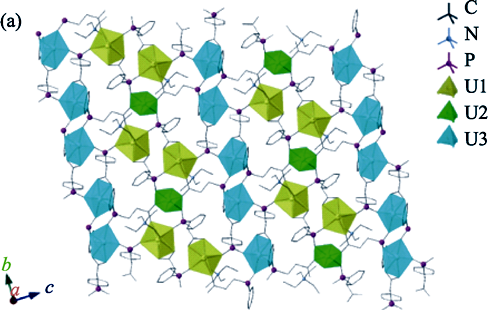
|
|
|
An Injectable Composite Bone Cement Based on Mesoporous Borosilicate Bioactive Glass Spheres
CHANG Yuchen, LIN Ziyang, XIE Xin, WU Zhangfan, YAO Aihua, YE Song, LIN Jian, WANG Deping, CUI Xu
2020 Vol. 35 (12): 1398–1406
 Abstract
Abstract(
522 )
 HTML
HTML(
32)
 PDF
PDF(7040KB)(
760
)
An injectable composite bone cement was fabricated by employing Sol-Gel derived mesoporous borosilicate bioactive glass spheres (MBGS) as solid phase and sodium alginate (SA) solution as liquid phase. The effects of the B2O3/SiO2 ratio in MBGS on its textural properties and workability, compressive strength and bioactivity of bone cement were characterized. It is found that with the increase of boron content, the specific surface area of MBGS increases from 161.71 m2/g to 214.28 m2/g, and the average pore size and total pore volume also increase, which accelerates the Ca2+ release and rapidly crosslinks MBGS and SA. Thus, the workability, mechanical property and in vitro mineralization of bone cement are significantly improved, as the setting time is shortened from 21 min to 9 min and the compressive strength is enhanced from 3.4 MPa to 4.1 MPa. Comprehensive performance of all aspects, BC-30 bone cement showing good workability, mechanical properties and in vitro mineralization ability, displays the optimal component. Therefore, improving the textural properties of MBGS is an effective method to enhance the workability, compressive strength and bioactivity of composite bone cement.
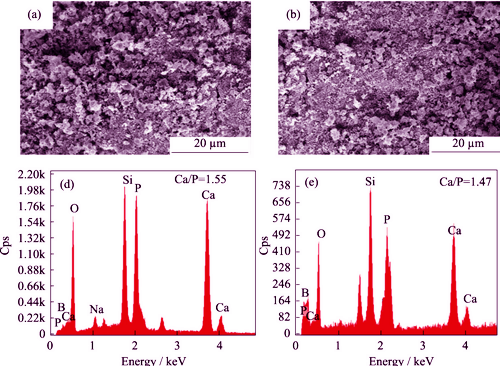
|
|